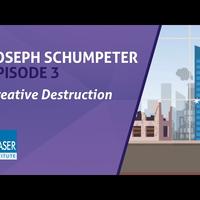Essential Schumpeter: Creative Destruction
Wesentlicher Schumpeter: Schöpferische Zerstörung
Schumpeter esencial: Destrucción creativa
L'essentiel de Schumpeter : Destruction créatrice
エッセンシャル・シュンペーター創造的破壊
필수 슘페터: 창조적 파괴
Esminis Schumpeteris: Kūrybinė destrukcija
Essential Schumpeter: Twórcza destrukcja
O essencial de Schumpeter: Destruição Criativa
Эссенциальный Шумпетер: Созидательное разрушение
Temel Schumpeter: Yaratıcı Yıkım
Есенціальний Шумпетер: Творче руйнування
熊彼特精要:创造性破坏
熊彼特精要:創造性破壞
Welcome to the essential ideas of Joseph Schumpeter.
The phrase “creative destruction” was popularized by economist Joseph
A expressão “destruição criativa” foi popularizada pelo economista Joseph
Schumpeter to describe the entrepreneurial process. What Schumpeter
Schumpeter para descrever o processo empreendedor. O que Schumpeter
observed is that entrepreneurship simultaneously creates something new...
observado é que o empreendedorismo simultaneamente cria algo novo...
while destroying something old. Consider this example: in the late 1800s the horse
enquanto destrói algo velho. Considere este exemplo: no final do século XIX, o cavalo
and buggy was the most widespread form of transportation and it included a vast
e o buggy era o meio de transporte mais difundido e incluía uma vasta
array of businesses and workers: people who raised horses... leather shops that
variedade de negócios e trabalhadores: pessoas que criam cavalos... lojas de couro que
made the harnesses and equipment... blacksmiths who forged and repaired the
faziam os arreios e equipamentos... ferreiros que forjavam e consertavam
виготовляли збрую та спорядження... ковалі, які кували та ремонтували
metal fittings, and so on. One day Jane, an entrepreneur, saw the vast potential for
acessórios de metal, e assim por diante. Um dia, Jane, uma empresária, viu o vasto potencial de
profit if a horse could be replaced by a machine.
lucro se um cavalo pudesse ser substituído por uma máquina.
Jane created a prototype that attracted some attention. At first these
Jane criou um protótipo que atraiu alguma atenção. A princípio esses
"automobiles" were an interesting novelty that attracted a few customers. But Jane
"automóveis" eram uma novidade interessante que atraiu alguns clientes. Mas Jane
made enough profit to pay her workers and other costs – the first sign she was
teve lucro suficiente para pagar seus trabalhadores e outros custos - o primeiro sinal de que ela estava
onto something. As Jane continued to innovate, more people wanted to buy her
em algo. Como Jane continuou a inovar, mais pessoas queriam comprá-la
на щось. Оскільки Джейн продовжувала впроваджувати інновації, все більше людей хотіли купувати її
automobiles. With the additional revenue, Jane hired more workers to speed up
automóveis. Com a receita adicional, Jane contratou mais funcionários para acelerar
production and moved into a larger space, which helped her lower prices, making
produção e mudou-se para um espaço maior, o que a ajudou a baixar os preços, tornando
the automobile accessible to more people. Soon, other entrepreneurs entered the
o automóvel acessível a mais pessoas. Logo, outros empresários entraram no
automobile industry and added further innovations, This eventually lowered the
indústria automobilística e acrescentou mais inovações, Isso acabou diminuindo o
price, and demand for automobiles increased… while demand for horse-and-
preço e a demanda por automóveis aumentou... enquanto a demanda por cavalos e
buggies declined. This transfer of resources from the horse and buggy
buggies recusou. Essa transferência de recursos do cavalo e da charrete
industry to the automobile industry had far reaching implications for the entire
indústria para a indústria automobilística teve implicações de longo alcance para todo o
economy.Stables that raised horses began laying off staff… leather shops switched
economia.Estábulos que criavam cavalos começaram a demitir funcionários... lojas de couro trocadas
switched to making leather car seats… and blacksmiths started fashioning parts for
passaram a fazer assentos de carro de couro... e os ferreiros começaram a fabricar peças para
переключилися на виготовлення шкіряних автомобільних сидінь... а ковалі почали виготовляти деталі для
automobiles. Eventually many of the old industry's workers found employment in
automóveis. Eventualmente, muitos dos trabalhadores da velha indústria encontraram emprego em
the new industry, or elsewhere in the growing economy. One of Schumpeter's
a nova indústria, ou em outro lugar na economia em crescimento. Um dos Schumpeter
greatest contributions to economics was his observation that the destructive
maiores contribuições para a economia foi sua observação de que o poder destrutivo
найбільшим внеском в економіку було його спостереження про те, що руйнівні
element to entrepreneurship was necessary to reap the rewards of new,
elemento para o empreendedorismo era necessário para colher os frutos do novo,
creative entrepreneurship and innovation. For more information on Joseph
empreendedorismo criativo e inovação. Para mais informações sobre José
Schumpeter, visit EssentialSchumpeter.org and to learn about more essential
scholars, visit EssentialScholars.org
estudiosos, visite EssentialScholars.org
and to learn about more essential
scholars visit essential scholars org
estudiosos visitam a organização de acadêmicos essenciais

